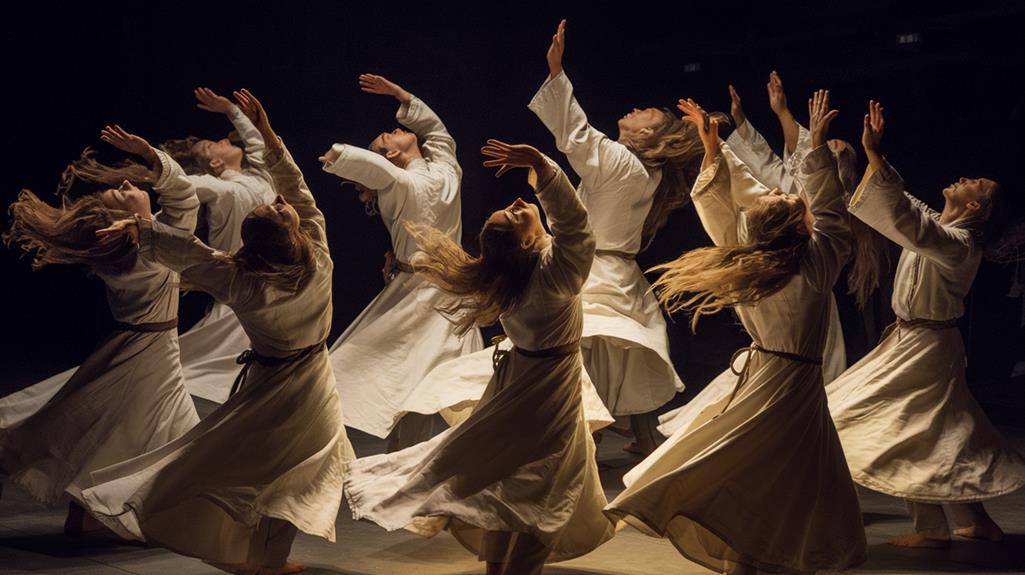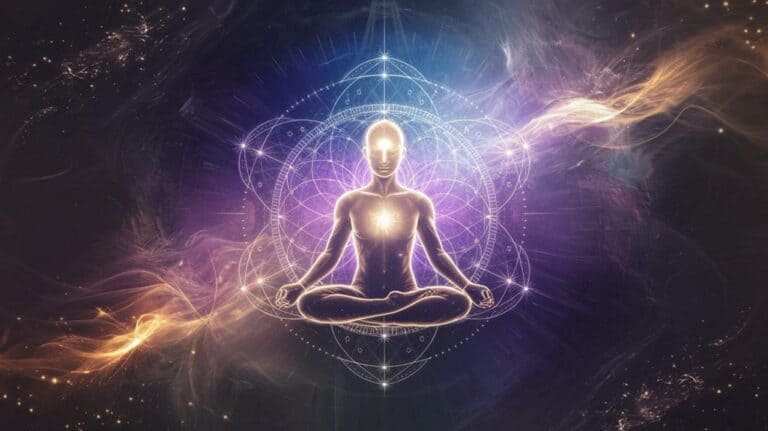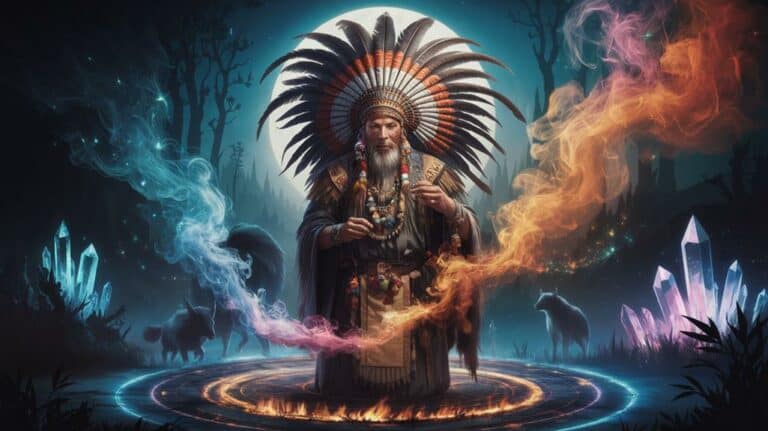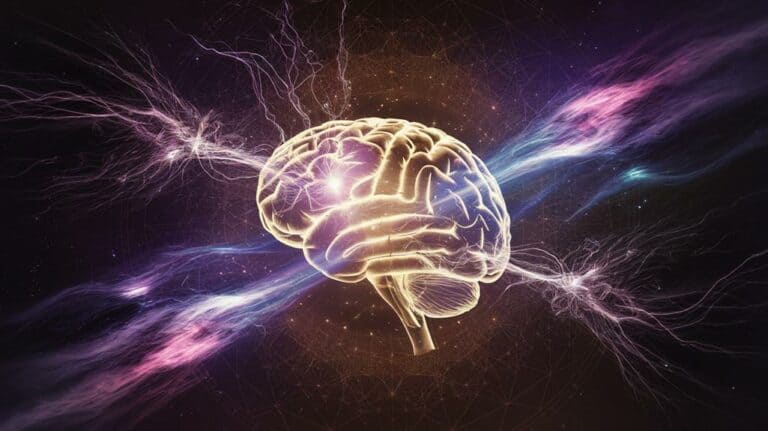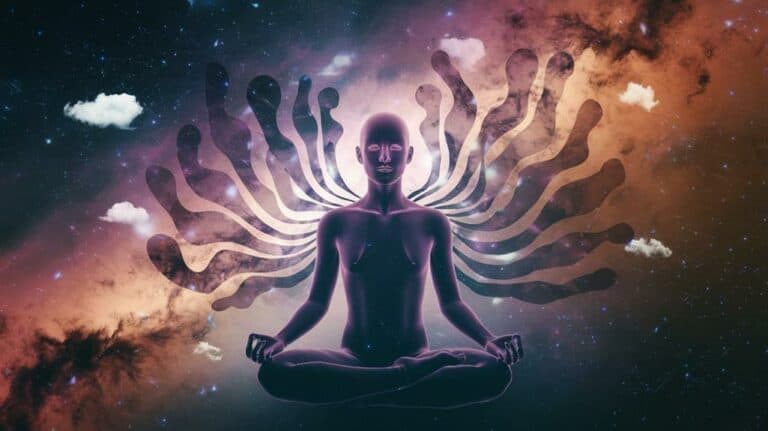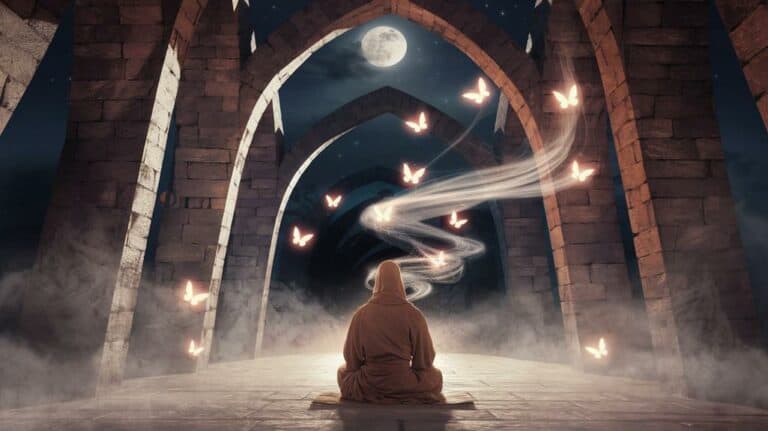Sufi Whirling and Ecstatic Dance in Mysticism
You’ll find that sacred movement has been a gateway to mystical experiences across cultures and throughout history. When you observe the mesmerizing rotations of Sufi dervishes or join the free-flowing expressions of modern ecstatic dance, you’re connecting to an ancient lineage of spiritual practices that transform ordinary motion into extraordinary transcendence. While the uninitiated might see mere spinning or dancing, these sacred movement traditions hold profound secrets about accessing altered states of consciousness and divine connection. The whirling dervish’s dedication to precise spiritual techniques and the ecstatic dancer’s surrender to spontaneous movement represent two paths toward the same mystical destination.
Origins of Sacred Movement
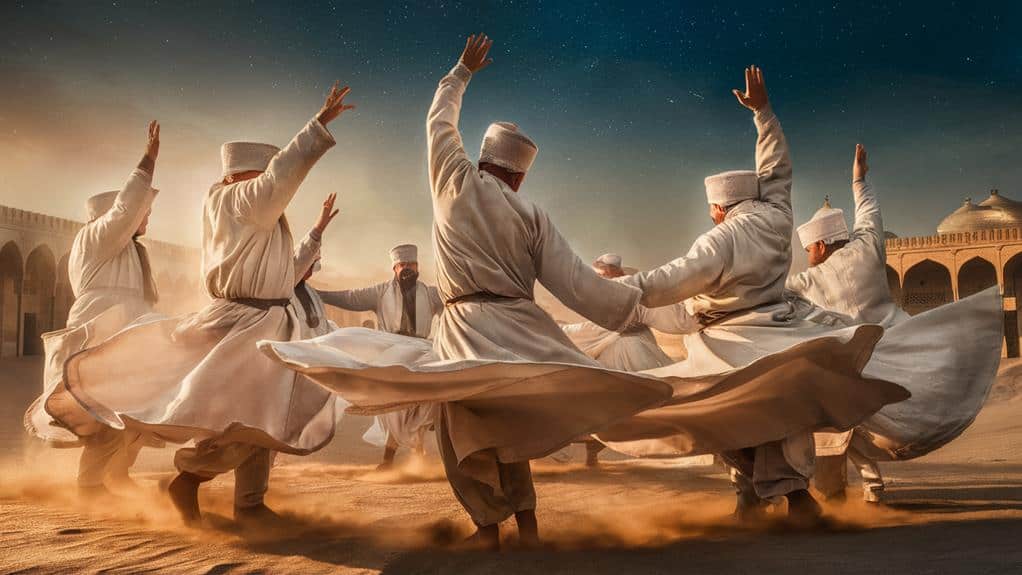
Throughout human history, sacred movement emerged as one of our earliest forms of spiritual expression. You’ll find evidence of ritual dance and sacred gestures woven into the fabric of every ancient civilization, from the temple dancers of Egypt to the spiritual ceremonies of indigenous peoples across continents.
When you explore these origins, you’ll discover how your ancestors used their bodies as living bridges between earthly existence and divine domains. They’d spin, sway, and move in patterns that mirrored celestial bodies, creating sacred geometries through their movements. You’re part of this unbroken lineage of seekers who’ve found transcendence through motion.
The origins of sacred movement aren’t confined to any single tradition – you’ll see it manifesting in shamanic practices, where dancers enter trance states to commune with spirits, and in ancient mystery schools where initiates learned sacred choreographies.
These early forms of movement meditation weren’t just performances; they were transformative practices that opened doorways to altered states of consciousness. Even today, when you engage in these age-old practices, you’re tapping into a profound current of human spiritual experience that’s flowed uninterrupted for millennia.
The Mevlevi Whirling Ceremony
Among the most enchanting forms of sacred movement, the Mevlevi Whirling Ceremony stands as a living proof of the mystical traditions of Sufism.
You’ll witness dervishes, adorned in white robes that symbolize death shrouds, as they begin their transformative journey through the Sema ritual. Their tall hats represent the ego’s tombstone, while their black cloaks, which they’ll shed, symbolize worldly attachments falling away.
As you observe the ceremony, you’ll notice how the whirling follows precise protocols established by Rumi himself. The dervishes extend their right arms upward to receive divine blessings, while their left arms point downward, channeling these blessings to Earth.
They’ll rotate counterclockwise around their hearts, creating a cosmic connection between heaven and Earth. You’re watching a meditation in motion, where each turn brings the dervish closer to spiritual ecstasy.
In this sacred space, you’ll find that time seems to dissolve as the dervishes spin, their movements creating a living metaphor for the planets orbiting the sun, reminding you of humanity’s place in the grand cosmic dance.
Physical Techniques and Training
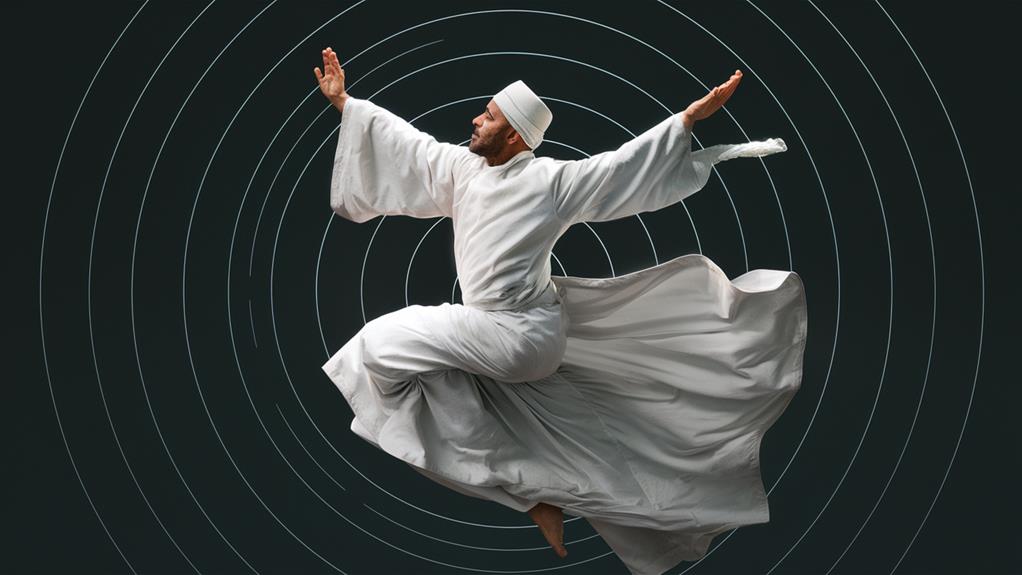
How do Sufi dervishes master the intricate art of whirling without losing their balance or becoming dizzy? The training begins with learning to focus on a fixed point while turning, much like ballet dancers spotting during pirouettes.
You’ll find that dervishes first learn to pivot on their left foot while pushing with their right, gradually building up speed and duration. The key lies in maintaining your center of gravity by keeping your spine straight and tilting your head slightly to the right.
Your training will progress through distinct stages, beginning with short intervals of spinning and gradually extending to longer durations. You’ll learn to distribute your weight evenly, allowing your arms to rise naturally as centrifugal force takes hold – your right palm facing upward toward heaven, your left palm facing downward toward earth.
The breath becomes your anchor, synchronized with your movements in a steady rhythm that helps maintain both physical and spiritual balance. Most importantly, you’ll discover that the dizziness subsides as you surrender to the motion, letting go of physical resistance and entering a state of profound spiritual receptivity.
Dance as Spiritual Technology
The physical mastery of whirling serves a deeper purpose: it functions as a powerful spiritual technology that transforms consciousness. Through sustained rotation and precise movements, you’ll find yourself accessing altered states that transcend ordinary perception, opening doorways to divine connection that your rational mind can’t reach alone.
As you whirl, you’re engaging an ancient system of embodied wisdom that aligns your physical form with cosmic rhythms. Your spinning creates a vortex of energy that dissolves the boundaries between inner and outer worlds, between self and divine presence.
The dervishes discovered that this practice isn’t merely symbolic – it’s a precise method for shifting consciousness through movement.
You’re tapping into what mystics have long understood: that the body itself can become an instrument of transcendence. Each revolution brings you closer to fana – the dissolution of the ego – as centrifugal force draws your awareness away from mundane concerns and toward the infinite.
This technology of ecstasy hasn’t lost its power over centuries; it remains a direct path to states of consciousness that words alone can’t capture.
Altered States Through Motion
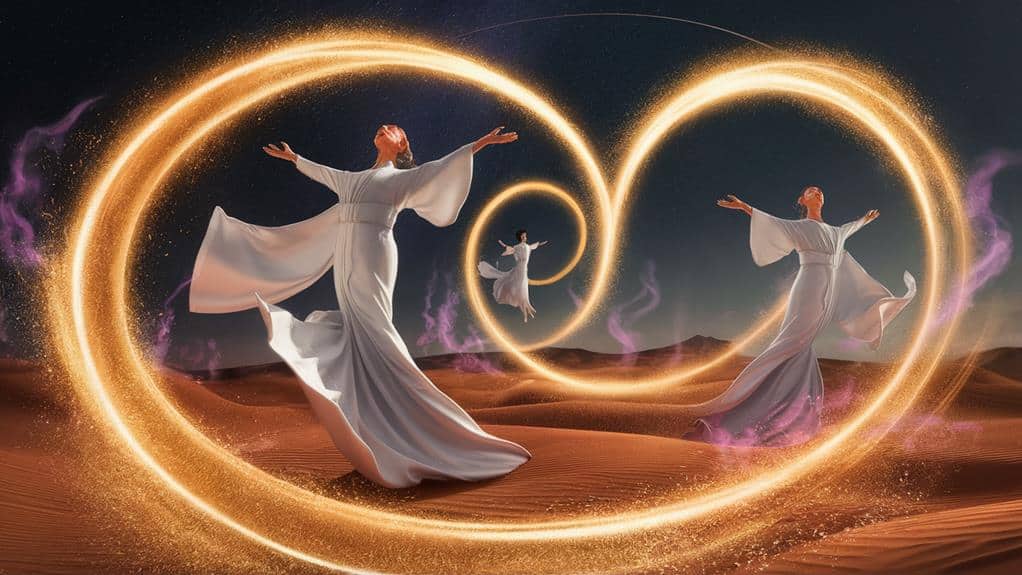
Whirling motions trigger three distinct physiological changes that alter consciousness: vestibular system stimulation, shifts in brain wave patterns, and changes in blood flow. As you spin, your inner ear’s delicate mechanisms become overwhelmed, creating a profound disconnection from ordinary spatial awareness.
You’ll notice your perception beginning to shift as your brain evolves from beta to alpha waves, opening doorways to heightened states of awareness. When you surrender to the circular motion, you’re engaging an ancient technology of transformation.
Your blood’s centrifugal movement creates subtle alterations in your brain’s chemistry, while the repetitive turning quiets your analytical mind. You’ll find yourself crossing thresholds of consciousness that mystics have accessed for centuries through this sacred practice.
The dizzying sensation isn’t something to resist – it’s the very mechanism that helps dissolve your ordinary boundaries of self. This altered state isn’t merely physical; it’s a gateway to transcendent experience.
As your body moves in circles, you’re participating in a practice that’s helped seekers access divine domains throughout history, using motion to bridge the gap between material and spiritual dimensions.
Cross-Cultural Mystical Dance Traditions
Mystical dance traditions span across five continents, revealing humanity’s universal drive to access divine spheres through movement.
You’ll find these sacred practices woven into the spiritual fabric of diverse cultures, from the whirling dervishes of Turkey to the ecstatic dancers of India’s Bhakti tradition. Each expression carries its own profound symbolism while sharing the common thread of transcendence through motion.
In Native American ceremonies, you’ll witness dancers embodying animal spirits and cosmic forces, their movements creating bridges between earthly and spiritual domains.
African traditions offer trance dances where you’re invited to surrender to rhythmic pulses that dissolve the boundaries between self and divine. These practices aren’t mere performances – they’re gateways to altered consciousness that you can access through dedicated practice and intention.
Whether you’re exploring the meditative spinning of Sufi mystics or the vigorous stamping of Tibetan Buddhist cham dancers, you’ll discover that these traditions share a common purpose: transforming ordinary movement into extraordinary spiritual revelation.
Through these diverse expressions, you’re connecting to an ancient lineage of seekers who’ve found their path to enlightenment through the wisdom of the dancing body.
Modern Ecstatic Dance Communities
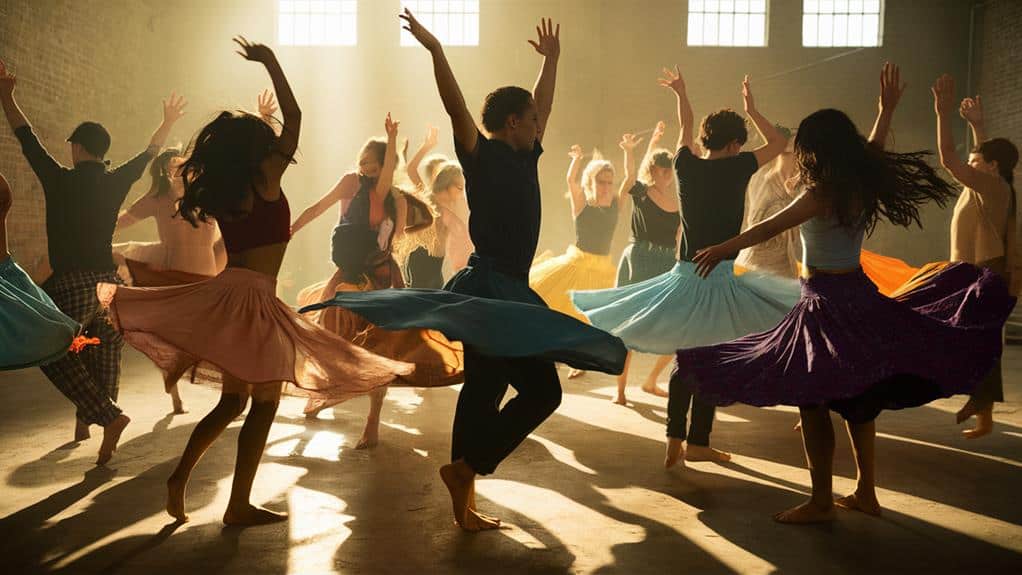
Modern practitioners have stepped out from ancient traditions to create vibrant ecstatic dance communities worldwide. You’ll find these gatherings in urban warehouses, beachfront festivals, and forest retreats, where dancers explore consciousness through free-form movement.
Unlike traditional ceremonies, there aren’t strict rules or religious frameworks – just an invitation to let your body become a vessel for authentic expression.
In these spaces, you’re encouraged to move as your spirit guides you, whether that’s spinning like a dervish or swaying gently to ambient rhythms. You’ll notice how the collective energy builds as dancers shed their inhibitions, creating a palpable field of shared intention and release.
Contemporary teachers often blend neuroscience with ancient wisdom, explaining how rhythmic movement can alter brain chemistry and facilitate profound states of awareness.
You’re part of a growing movement that’s reclaiming dance as a pathway to transformation. These communities honor the mystical roots of ecstatic dance while adapting practices for modern seekers.
Through conscious movement, you’re participating in an evolving tradition that bridges ancient spiritual technologies with contemporary understanding of embodied awakening.



